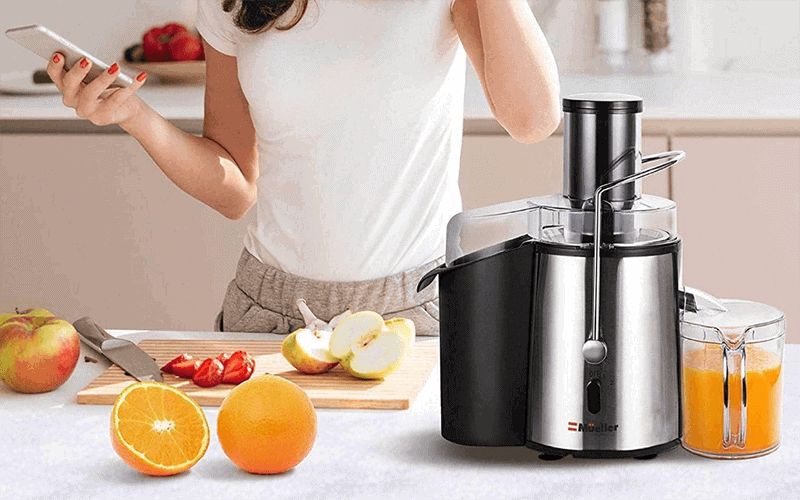Do you want to buy a slow juicer? Perhaps you are curious about the difference between a slow juicer and juice extractor. Homemade juice from organic ingredients is the best.
You can make new juices every day. It is healthy and delicious. You can be sure what is in your juice and you get a 100% natural, pure drink without any artificial additives.
It is up to you to decide which juicer you should use. We have compared two of the most popular types of juice extractors and slow juicers to help you make an informed decision.
For Short Time Readers
What is the difference between a slow juicer and juice extractor?
Our juicer comparison will compare the best juicers, and then show you all of the purchase-related criteria. While we aren’t trying to stop anyone from making this choice, we will list below the differences.
We also list the pros and cons to help buyers get a better view of slow juicers and juice extractors.
The purchase decision should therefore be taken quickly.
| Slow Juicer | Juice Extractor | |
| Speed | 3x Much Slower Than Fast | Fast |
| Pulp | A lot | A few |
| Price | Higher | Lower |
| Noise Level | Silent | Slightly Louder |
| Buy Now | Buy Now |
What is a juice centrifugal extractor, and how does it work?
This device uses centrifugal force to shred the vegetables and fruits.
The container can also rotate around itself at a speed of up to 15,000 revolutions per minute.
Centrifugal force creates a “spout” that allows juice to be “thrown” from the vegetable and fruit pieces. The juice flows into a spout and the pomace goes into another container.
The high rotation speeds of the juicers ensure that fruits and vegetables can be juiced quickly and in larger quantities.
This is why centrifugal extractors are so common in gastronomy.
High revolutions can lead to heat development.
The juice can lose valuable nutrients such as vitamins, enzymes, and other essential nutrients. The juice also loses its quality due to oxygen. This can happen in terms of both of the ingredients and in terms of taste and shelf life.
You can juice any hard fruit and vegetables, including celery, apples, and beetroot without having to prepare or overload the device.
What is a juicer, and how does it work?
A juicer is also known as a slow or cold juicer. It extracts the fruits and vegetables mechanically by crushing them with a powerful wave.
A rotating cutter is used to make porridge. Then, a sieve is used to squeeze the contents through a sieve.
Another juice press extracts the juice from the vegetables and fruits using slow rotating screw presses.
Counter-rotating pressure rollers are also available to crush the pressed material. This produces pomace which is also drier than a centrifuge.
The average number of revolutions in an excellent juicer is between 40 to 80 per minute. A slow juicer can only go up to 200 revolutions per hour.
It is much more stable than heat and therefore less oxidation. This allows valuable vitamins and nutrients to be preserved better.
Press rolls pose the lowest risk of oxidation because they have the least surface area for oxygen and are smooth.
The juice’s mineral content should be high if the press rolls have magnets.
The slow juicer has another advantage: it can handle even the most difficult crops like herbs (parsley, for example). berries, leafy vegetables (such as spinach or cabbage), grasses and wild herbs, as well sprouts.
Also, soft and hard-pressed materials make delicious cold juices almost with a playful touch.
It is important that you juice both soft and hard ingredients.
Why is oxidation harmful?

You are expected to make fresh juice. You can expect to have a positive effect on your health and well-being.
The higher the level, the more nutrients are in the juice. We would like to examine the topic of “oxidation.”
As we have already mentioned, juicing with juice extractors provides oxygen to the crop. It oxidizes. When you slice it, it looks like an apple.
It quickly turns brown when exposed to oxygen.
This process releases energy. This is because electrons are released from the oxidizing substance.
The result is that the substances existing are altered or destroyed, especially valuable vitamins/enzymes.
You want to get energy from freshly squeezed juices.
This can lead to less energy for your body if it is taken out of the juice extractor’s ingredients during the pressing process.
Yes, vitamins and enzymes are still present in the juice, but they will be less than if the juice was made with a slow, gentle juicer that turns a lot more.
Slow juicer or juice extractor?
- Slow juicers work better when there is less oxidation.
- It also gives you more fiber.
- Slow juicers are more nutritious than juices.
- Slow juicers yield much more juice.
- It is easy to clean a slow juicer that has a self-cleaning feature.
- The juice extractor is faster, looks great, and is very easy to clean, even without the self-cleaning function.
If left cold, the juice from both devices can be consumed for up to 48 hours.
Advantages of a juice extractor
- The large filling shaft means that you don’t need to mince ingredients or even a very small amount.
- Juicing large quantities of juice is possible quickly due to the high revolution rate of up to 15,000 revolutions per hour.
- These points will result in less time spent juicing.
- Juice extractors can be very affordable in the beginning.
Disadvantages of a juice extractor
- The centrifugal force causes a lot of heat and more oxidation. The juice can sometimes lose a lot of its quality. It is less nutritious and has a more bitter taste.
- You can’t keep the juices for long because of the oxidized ingredients.
- Problems with long-fiber ingredients such as wild herbs, wheatgrass, barley grass, cabbage, celery, and other grasses can cause juice extractor problems.
- Cleaning the equipment can be more difficult and knives lose their sharpness faster.
- A juice extractor produces a high volume of juice during operation.
- The juice yield is lower.
Advantages of a slow juicer
- The material to press is gently juiced. The juice retains many vitamins and enzymes that are necessary for healthy living.
- To get healthy green juices with valuable chlorophyll, such as wild herbs, you can also juice long-fiber ingredients like wheatgrass using a juicer
- The juice is much more consistent and homogeneous. Aside from that, there is very little foam during production.
- A slow juicer will usually yield more juice than a juice extractor.
- These devices also have a lower volume.
- A slow juicer allows you to do more – you can make ice cream and pasta with it.
Disadvantages of a slow juicer
- Partially smaller feed shafts are found in juice presses. There is now also a variety of juicers with XXL openings. Kuvings B6000 and Optimum 700 are examples.
- You will need to allow for a longer time to prepare some models, as you may need to reduce the ingredients.
- Juicing can also cause blockages if there is too much-pressed material.
- This means that slow juicing takes longer.
- The cost of a slow juicer is typically higher. They start at 350 dollars and can reach $550. In some cases like the Angel Juicer, even more.
Are there alternatives to these two devices?
- Yes. You can also make your own juicer. This requires a lot more power, but it is still the most cost-effective way to make juice.
A mixer can also be used as an alternative. You can also use the blender to prepare other foods.
The mixer is very hot and can cause vitamin deficiency.
It works quickly, so the loss is minimal. The high-performance mixer is even better.
This is a true miracle device that can also be very expensive.
This device allows you to make soups that are high-quality and creamy. There are options for everyone and every budget.
Wrapping Up
For those who are more experienced, slow juicers are a better choice.
A horizontal juicer is better if juicing is a frequent activity. A vertical juicer will suffice in most cases.
We recommend the slow juicer over the juice extractor.
This is especially true for juices that contain high levels of nutrients and full flavors.
We find the slightly longer preparation time to be negligible. With some experience, however, it is not enough to clog juicing.
While the juice extractor is simpler to clean, some slow juicers have a self-cleaning function that can be purchased for a higher price.
You must weigh the pros and cons of each device.
A slow juicer will make it easier to squeeze fresh juices every day. The juice is more flavorful, lasts longer and tastes better.







